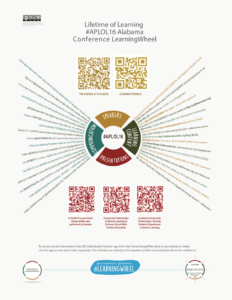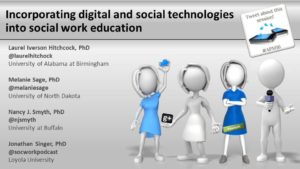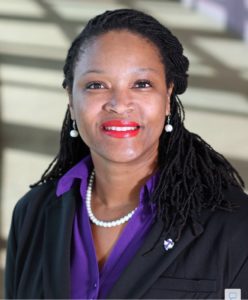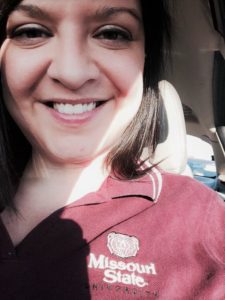Teaching with Infographics: My experiences with digital literacy and non-traditional students
Nathalie P. Jones, PhD, MSW is an Assistant Professor of Social Work at Tarleton State University. In this blog post, Dr. Jones writes about her experiences creating and implementing an infographic assignment with nontraditional social work students.
As an Assistant Professor of Social Work at Tarleton State University, I have absolutely enjoyed educating social work students on the use of technology through macro social work practice courses. I teach a large number of non-traditional learners (those who have been out of school for longer than one year, and are employed, parenting, or in any other roles that are competing with being a learner as defined by the National Center for Education Statistics [2015]). I find that they develop student groups quickly in order to have support while working on assignments, especially those assignments that include the use of digital technology.
To help my students improve their understanding of digital and social technology, I have introduced the use of infographics during an advanced social work course entitled Women’s Issues. Infographics are visual representations of almost any type of information. Infographics are similar to storytelling with visual content and supported with statistical data. They are an effective way to communicate large amounts of information in a clear and succinct way, and are an increasingly popular tool in popular media and the non-profit world (NonProfit Tech for Good, 2014). Understanding how to create, share and evaluate infographics is a key digital literacy skill for social workers (Shelly, 2015). Along with all these benefits, I wanted to create an assignment that was fun and engaging for my nontraditional students who are often nervous about nontraditional, digital assignments.
For the Women’s Issues course, I asked students to research an issue or social problem affecting women, turn that research into an infographic (rather than a written paper), and then share their infographics with professionals outside of the class as a way to network with alliances who advocate on behalf of women. This meant students needed to not only create a quality artifact for a grade, but also learn how to share it with other advocates in a public way – via social media. In an effort to support learners who were experiencing technology in college for the first time, I provided them with seven detailed steps to successfully complete the infographic assignment. These steps involved learning about Twitter as well as creating an infographic.
Here are the assignment steps directly from the course syllabus:
Step 1: Create a Twitter Account & provide your Twitter Handle. *Don’t forget to follow the instructor.
Step 2: Research & provide a resource of two infographics (1) from the web and (1) from Twitter related to Women’s Issues. Then, provide a 1-2 page comparison on how the infographic was distributed, what was learned & why this is a resource for issues related to women.
The Shared Case Study: An online activity for Interprofessional Teamwork
Natalie Curry, LCSW is a Clinical Instructor at Missouri State University’s (MSU) School of Social Work. She has been on the faculty with MSU for two years and prior to that was an adjunct instructor for MSU, Drury University, and Washington University in St. Louis. Prior to entering academia, her practice background includes working with individuals who were homeless in various capacities, inpatient psychiatric care, and behavioral health consulting in primary care. In this post, she writes about an online, interprofessional learning activity that she helped to develop and implement with colleagues at MSU You can follow Natalie on Twitter at @natalielcsw.
Last fall, there was considerable interest around interprofessional education in the College of Health and Human Services (CHHS) at Missouri State University (MSU), where I work. My colleagues and I believed that we were doing well at talking with our students about how much collaboration they would do in their careers with other healthcare professionals. But we wanted to go further and figure out ways to provide the students real opportunities for interprofessional practice in their educational programs. That was part of the motivation for bringing together faculty from all 11 disciplines (such as social work, nursing, medicine and others) within CHHS, in addition to the University of Missouri-Kansas City School of Pharmacy which was already in partnership with MSU. The other part of motivation was a growing recognition that interprofessional activities were no longer just encouraged in many of our disciplines’ accreditation standards; they were required.
Starting in Fall 2015, our committee to begin developing interprofessional educational activities for our students. We met monthly and eventually decided that it was not feasible to develop one activity, project, or experience that all students from CHHS could do together and still be meaningful. We decided on four “menu items” that each discipline could choose to participate in, depending on the needs of their students. We wanted to have a mix of interprofessional activities, ranging from one-day experiences to projects that could be implemented over the course of a semester.
Social Work Educator’s Guide for #SWVirtualPal
This guide to explains the hashtag #SWVirtualPal and how you might incorporate it into course content, a class assignment or learning activity. You can also download a PDF version of this guide.
The purpose of the #SWVirtualpal hashtag is to create professional connections between social work students, practitioners, and academics across the planet. It was created by Amanda Taylor from the University of Central Lancashire in the United Kingdom, and Laurel Iverson Hitchcock from the University of Alabama at Birmingham in the United States. To learn more about #SWVirtualPal, read this blog post.
Why #SWVirtualpal in Social Work Education?
 Pen Pals have been a ‘thing’ for a very long time. The earliest record of their usage, that we can find, is reported as being led by an ‘innovative Iowa teacher’ called Birdie Matthews, who at the time employed the methodology to bring the realities of WW II into the classroom (Myers-Verhage, 1995). Matthews creativity in the classroom quite possibly led to one of the most famous pen pal relationships of all time, and this was between Juanita Wagner (her student at the time) and Anne Frank. So why are we telling you all of this? Well, before the internet the likelihood of a social work academic in the US, working closely and supportively with a social work academic in the UK would have been ‘virtually’ unheard of, or indeed a fairly disparate affair, which would have been laborious to maintain. However, thankfully for us technologies have changed the way we work and the way we connect. Today’s digital and social media present all sorts of possibilities and opportunities; and being social workers with our default set on creativity, we decided quite a way back now to exploit all it is that technology affords.
Pen Pals have been a ‘thing’ for a very long time. The earliest record of their usage, that we can find, is reported as being led by an ‘innovative Iowa teacher’ called Birdie Matthews, who at the time employed the methodology to bring the realities of WW II into the classroom (Myers-Verhage, 1995). Matthews creativity in the classroom quite possibly led to one of the most famous pen pal relationships of all time, and this was between Juanita Wagner (her student at the time) and Anne Frank. So why are we telling you all of this? Well, before the internet the likelihood of a social work academic in the US, working closely and supportively with a social work academic in the UK would have been ‘virtually’ unheard of, or indeed a fairly disparate affair, which would have been laborious to maintain. However, thankfully for us technologies have changed the way we work and the way we connect. Today’s digital and social media present all sorts of possibilities and opportunities; and being social workers with our default set on creativity, we decided quite a way back now to exploit all it is that technology affords.
Using Learning Wheels: The #APLOL16 Connected Conference
In this short blog, we (Amanda Taylor and Laurel Hitchcock) outline the success of the #APLOL16 Conference LearningWheel and through doing so hope to encourage social work and indeed other professions to consider this methodology as a conduit for collating and disseminating conference content.
Why a Conference Learning Wheel?
 I reached out to Amanda earlier this year about setting up a Conference LearningWheel for Alabama Possible’s 2016 Lifetime of Learning Conference because I had previously participated in the development of LearningWheels for other conferences, and saw several benefits for #APLOL16. First, a Conference LearningWheel helps document learning that occurs during and after a conference. By contributing short sentences (which become spokes of the wheel), conference attendees can share their insights, feedback and comments about the different conference sessions with an audience beyond that session and even beyond the conference. Second, the LearningWheel also captures how conference attendees can best communicate with each other during or after a conference, and with others such as colleagues, students, community partners, or any like-minded person. This is ideal for encouraging conference attendees to apply what they learned in their professional settings and promote collaborations. Finally, I hope Alabama Possible can use the Conference LearningWheel as an evaluation tool to help assess the outcomes from #APLOL16 and to plan next year’s conference.
I reached out to Amanda earlier this year about setting up a Conference LearningWheel for Alabama Possible’s 2016 Lifetime of Learning Conference because I had previously participated in the development of LearningWheels for other conferences, and saw several benefits for #APLOL16. First, a Conference LearningWheel helps document learning that occurs during and after a conference. By contributing short sentences (which become spokes of the wheel), conference attendees can share their insights, feedback and comments about the different conference sessions with an audience beyond that session and even beyond the conference. Second, the LearningWheel also captures how conference attendees can best communicate with each other during or after a conference, and with others such as colleagues, students, community partners, or any like-minded person. This is ideal for encouraging conference attendees to apply what they learned in their professional settings and promote collaborations. Finally, I hope Alabama Possible can use the Conference LearningWheel as an evaluation tool to help assess the outcomes from #APLOL16 and to plan next year’s conference.
#APM16 Day 4 – A Toolkit for Social and Digital Media Policies in Field Education
 It is the last day of CSWE’s 2016 Annual Program Meeting in Atlanta, and I am presenting with one of my favorite UA colleagues, Allison Curington, at 10:00 AM in Atlanta Marriott Marquis Hotel International 8. We will be talking about a project that we have been working on for the past year, a Toolkit for Social and Digital Media Policies in Field Education. Allison and I started collaborating on this toolkit after many, many conversations about the growing use (and misuse) of social media in field education by students, educators and field supervisors. We saw that field directors were increasingly dealing with ethical and practical issues related to the use of social and digital media in field education, and we wanted to provide information and tools to help field directors raise awareness with students and field supervisors.
It is the last day of CSWE’s 2016 Annual Program Meeting in Atlanta, and I am presenting with one of my favorite UA colleagues, Allison Curington, at 10:00 AM in Atlanta Marriott Marquis Hotel International 8. We will be talking about a project that we have been working on for the past year, a Toolkit for Social and Digital Media Policies in Field Education. Allison and I started collaborating on this toolkit after many, many conversations about the growing use (and misuse) of social media in field education by students, educators and field supervisors. We saw that field directors were increasingly dealing with ethical and practical issues related to the use of social and digital media in field education, and we wanted to provide information and tools to help field directors raise awareness with students and field supervisors.
In our interactive workshop today, we plan to present on the toolkit for the first time and pilot one of the tools – Social Media Policy Checklist and Worksheet for Social Workers. We hope you will join us.
#APM16 Day 3 -Incorporating Digital & Social Technologies into Social Work Education
 This is Day 2 of CSWE’s 2016 Annual Program Meeting, and it will be a busy day. One of the highlights for me will be presenting as part of panel of other #swtech educators – Drs. Melanie Sage (University of North Dakota), Jonathan B. Singer (Loyola University & The Social Work Podcast) and Nancy J. Smyth (University at Buffalo, SUNY). Our panel discussion is about how to how to infuse social and digital technologies into social work courses and curricula. Topics will focus on digital literacy, using theory to inform the integration of technology into online courses, and creating assignments and learning activities for social work courses that incorporate technology.
This is Day 2 of CSWE’s 2016 Annual Program Meeting, and it will be a busy day. One of the highlights for me will be presenting as part of panel of other #swtech educators – Drs. Melanie Sage (University of North Dakota), Jonathan B. Singer (Loyola University & The Social Work Podcast) and Nancy J. Smyth (University at Buffalo, SUNY). Our panel discussion is about how to how to infuse social and digital technologies into social work courses and curricula. Topics will focus on digital literacy, using theory to inform the integration of technology into online courses, and creating assignments and learning activities for social work courses that incorporate technology.




